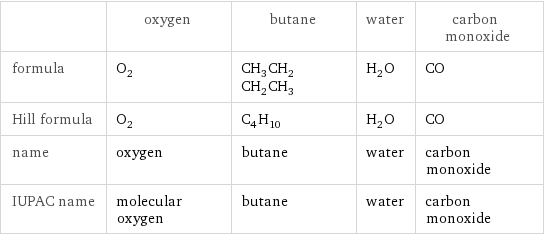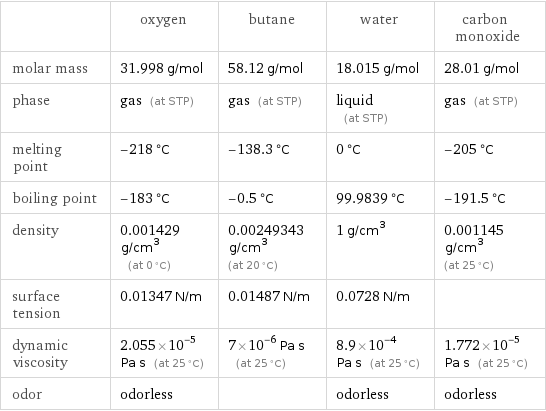Input interpretation

O_2 oxygen + CH_3CH_2CH_2CH_3 butane ⟶ H_2O water + CO carbon monoxide
Balanced equation

Balance the chemical equation algebraically: O_2 + CH_3CH_2CH_2CH_3 ⟶ H_2O + CO Add stoichiometric coefficients, c_i, to the reactants and products: c_1 O_2 + c_2 CH_3CH_2CH_2CH_3 ⟶ c_3 H_2O + c_4 CO Set the number of atoms in the reactants equal to the number of atoms in the products for O, C and H: O: | 2 c_1 = c_3 + c_4 C: | 4 c_2 = c_4 H: | 10 c_2 = 2 c_3 Since the coefficients are relative quantities and underdetermined, choose a coefficient to set arbitrarily. To keep the coefficients small, the arbitrary value is ordinarily one. For instance, set c_2 = 1 and solve the system of equations for the remaining coefficients: c_1 = 9/2 c_2 = 1 c_3 = 5 c_4 = 4 Multiply by the least common denominator, 2, to eliminate fractional coefficients: c_1 = 9 c_2 = 2 c_3 = 10 c_4 = 8 Substitute the coefficients into the chemical reaction to obtain the balanced equation: Answer: | | 9 O_2 + 2 CH_3CH_2CH_2CH_3 ⟶ 10 H_2O + 8 CO
Structures

+ ⟶ +
Names

oxygen + butane ⟶ water + carbon monoxide
Reaction thermodynamics
Enthalpy

| oxygen | butane | water | carbon monoxide molecular enthalpy | 0 kJ/mol | -125.7 kJ/mol | -285.8 kJ/mol | -110.5 kJ/mol total enthalpy | 0 kJ/mol | -251.4 kJ/mol | -2858 kJ/mol | -884 kJ/mol | H_initial = -251.4 kJ/mol | | H_final = -3742 kJ/mol | ΔH_rxn^0 | -3742 kJ/mol - -251.4 kJ/mol = -3491 kJ/mol (exothermic) | | |
Equilibrium constant
![Construct the equilibrium constant, K, expression for: O_2 + CH_3CH_2CH_2CH_3 ⟶ H_2O + CO Plan: • Balance the chemical equation. • Determine the stoichiometric numbers. • Assemble the activity expression for each chemical species. • Use the activity expressions to build the equilibrium constant expression. Write the balanced chemical equation: 9 O_2 + 2 CH_3CH_2CH_2CH_3 ⟶ 10 H_2O + 8 CO Assign stoichiometric numbers, ν_i, using the stoichiometric coefficients, c_i, from the balanced chemical equation in the following manner: ν_i = -c_i for reactants and ν_i = c_i for products: chemical species | c_i | ν_i O_2 | 9 | -9 CH_3CH_2CH_2CH_3 | 2 | -2 H_2O | 10 | 10 CO | 8 | 8 Assemble the activity expressions accounting for the state of matter and ν_i: chemical species | c_i | ν_i | activity expression O_2 | 9 | -9 | ([O2])^(-9) CH_3CH_2CH_2CH_3 | 2 | -2 | ([CH3CH2CH2CH3])^(-2) H_2O | 10 | 10 | ([H2O])^10 CO | 8 | 8 | ([CO])^8 The equilibrium constant symbol in the concentration basis is: K_c Mulitply the activity expressions to arrive at the K_c expression: Answer: | | K_c = ([O2])^(-9) ([CH3CH2CH2CH3])^(-2) ([H2O])^10 ([CO])^8 = (([H2O])^10 ([CO])^8)/(([O2])^9 ([CH3CH2CH2CH3])^2)](../image_source/6a2d542339380722e7eaa5121fd7397c.png)
Construct the equilibrium constant, K, expression for: O_2 + CH_3CH_2CH_2CH_3 ⟶ H_2O + CO Plan: • Balance the chemical equation. • Determine the stoichiometric numbers. • Assemble the activity expression for each chemical species. • Use the activity expressions to build the equilibrium constant expression. Write the balanced chemical equation: 9 O_2 + 2 CH_3CH_2CH_2CH_3 ⟶ 10 H_2O + 8 CO Assign stoichiometric numbers, ν_i, using the stoichiometric coefficients, c_i, from the balanced chemical equation in the following manner: ν_i = -c_i for reactants and ν_i = c_i for products: chemical species | c_i | ν_i O_2 | 9 | -9 CH_3CH_2CH_2CH_3 | 2 | -2 H_2O | 10 | 10 CO | 8 | 8 Assemble the activity expressions accounting for the state of matter and ν_i: chemical species | c_i | ν_i | activity expression O_2 | 9 | -9 | ([O2])^(-9) CH_3CH_2CH_2CH_3 | 2 | -2 | ([CH3CH2CH2CH3])^(-2) H_2O | 10 | 10 | ([H2O])^10 CO | 8 | 8 | ([CO])^8 The equilibrium constant symbol in the concentration basis is: K_c Mulitply the activity expressions to arrive at the K_c expression: Answer: | | K_c = ([O2])^(-9) ([CH3CH2CH2CH3])^(-2) ([H2O])^10 ([CO])^8 = (([H2O])^10 ([CO])^8)/(([O2])^9 ([CH3CH2CH2CH3])^2)
Rate of reaction
![Construct the rate of reaction expression for: O_2 + CH_3CH_2CH_2CH_3 ⟶ H_2O + CO Plan: • Balance the chemical equation. • Determine the stoichiometric numbers. • Assemble the rate term for each chemical species. • Write the rate of reaction expression. Write the balanced chemical equation: 9 O_2 + 2 CH_3CH_2CH_2CH_3 ⟶ 10 H_2O + 8 CO Assign stoichiometric numbers, ν_i, using the stoichiometric coefficients, c_i, from the balanced chemical equation in the following manner: ν_i = -c_i for reactants and ν_i = c_i for products: chemical species | c_i | ν_i O_2 | 9 | -9 CH_3CH_2CH_2CH_3 | 2 | -2 H_2O | 10 | 10 CO | 8 | 8 The rate term for each chemical species, B_i, is 1/ν_i(Δ[B_i])/(Δt) where [B_i] is the amount concentration and t is time: chemical species | c_i | ν_i | rate term O_2 | 9 | -9 | -1/9 (Δ[O2])/(Δt) CH_3CH_2CH_2CH_3 | 2 | -2 | -1/2 (Δ[CH3CH2CH2CH3])/(Δt) H_2O | 10 | 10 | 1/10 (Δ[H2O])/(Δt) CO | 8 | 8 | 1/8 (Δ[CO])/(Δt) (for infinitesimal rate of change, replace Δ with d) Set the rate terms equal to each other to arrive at the rate expression: Answer: | | rate = -1/9 (Δ[O2])/(Δt) = -1/2 (Δ[CH3CH2CH2CH3])/(Δt) = 1/10 (Δ[H2O])/(Δt) = 1/8 (Δ[CO])/(Δt) (assuming constant volume and no accumulation of intermediates or side products)](../image_source/750d484b2c438aa01c85696d25b180c1.png)
Construct the rate of reaction expression for: O_2 + CH_3CH_2CH_2CH_3 ⟶ H_2O + CO Plan: • Balance the chemical equation. • Determine the stoichiometric numbers. • Assemble the rate term for each chemical species. • Write the rate of reaction expression. Write the balanced chemical equation: 9 O_2 + 2 CH_3CH_2CH_2CH_3 ⟶ 10 H_2O + 8 CO Assign stoichiometric numbers, ν_i, using the stoichiometric coefficients, c_i, from the balanced chemical equation in the following manner: ν_i = -c_i for reactants and ν_i = c_i for products: chemical species | c_i | ν_i O_2 | 9 | -9 CH_3CH_2CH_2CH_3 | 2 | -2 H_2O | 10 | 10 CO | 8 | 8 The rate term for each chemical species, B_i, is 1/ν_i(Δ[B_i])/(Δt) where [B_i] is the amount concentration and t is time: chemical species | c_i | ν_i | rate term O_2 | 9 | -9 | -1/9 (Δ[O2])/(Δt) CH_3CH_2CH_2CH_3 | 2 | -2 | -1/2 (Δ[CH3CH2CH2CH3])/(Δt) H_2O | 10 | 10 | 1/10 (Δ[H2O])/(Δt) CO | 8 | 8 | 1/8 (Δ[CO])/(Δt) (for infinitesimal rate of change, replace Δ with d) Set the rate terms equal to each other to arrive at the rate expression: Answer: | | rate = -1/9 (Δ[O2])/(Δt) = -1/2 (Δ[CH3CH2CH2CH3])/(Δt) = 1/10 (Δ[H2O])/(Δt) = 1/8 (Δ[CO])/(Δt) (assuming constant volume and no accumulation of intermediates or side products)
Chemical names and formulas

| oxygen | butane | water | carbon monoxide formula | O_2 | CH_3CH_2CH_2CH_3 | H_2O | CO Hill formula | O_2 | C_4H_10 | H_2O | CO name | oxygen | butane | water | carbon monoxide IUPAC name | molecular oxygen | butane | water | carbon monoxide
Substance properties

| oxygen | butane | water | carbon monoxide molar mass | 31.998 g/mol | 58.12 g/mol | 18.015 g/mol | 28.01 g/mol phase | gas (at STP) | gas (at STP) | liquid (at STP) | gas (at STP) melting point | -218 °C | -138.3 °C | 0 °C | -205 °C boiling point | -183 °C | -0.5 °C | 99.9839 °C | -191.5 °C density | 0.001429 g/cm^3 (at 0 °C) | 0.00249343 g/cm^3 (at 20 °C) | 1 g/cm^3 | 0.001145 g/cm^3 (at 25 °C) surface tension | 0.01347 N/m | 0.01487 N/m | 0.0728 N/m | dynamic viscosity | 2.055×10^-5 Pa s (at 25 °C) | 7×10^-6 Pa s (at 25 °C) | 8.9×10^-4 Pa s (at 25 °C) | 1.772×10^-5 Pa s (at 25 °C) odor | odorless | | odorless | odorless
Units
